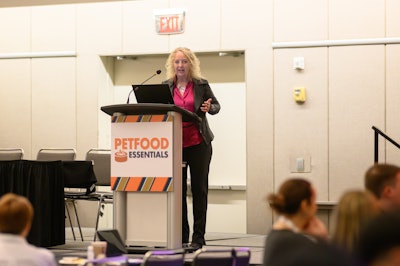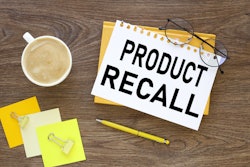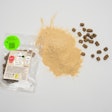
In the post-COVID world, some consumer behaviors also affect pets, such as snacking, as well as trends around sustainability and functionality, according to Suzy Badaracco, president of food industry trends think tank Culinary Tides, who spoke April 29 at Petfood Essentials in Kansas City, Missouri.
“Snacking is up with humans, so snacking could still be up with pets, but usually it’s due to finances,” she said. “So, in other words, what happens is I snack more because I can’t afford a meal. So, think about what’s going to happen to the pet: Are they cutting back on food and giving them snacks instead to save money?”
Because snacks – or treats, in the case of pets – might be replacing meals, consumers want those snacks to be functional, or have specific health benefits beyond just alleviating hunger.
“Consumers are interested in products that have functional benefits,” Badaracco said. “They don’t have as much money, they may be using snacks as a secondary meal substitution. They want functional. They want functional in meals, they want functional in snacks. So again, what is the secondary benefit to the snack other than it’s an indulgent treat?”
In addition to being willing to pay more for functional treats, consumers say they are willing to pay more for clean-label brands.
According to data Badaracco cited, 91% of consumers snack multiple times per day and 65% of consumers want an energy boost from their snacks; the snacks they seek are “not 100% indulgent,” meaning they want a functional overlay to those snacks.
Consumers want “value-added” snacks or treats for themselves and their pets. It is up to producers to fill the gap in the marketplace.
“The gap is producers are lacking snack products with dual personality like health plus indulgence within the snack,” Badaracco said. “Value-added snacks are well supported. However, not many brands promote them as that. Snacks often don’t engage trends, which is a huge mistake.”
Pet treat producers should strive to give pet owners treats they look forward to giving their pets and that become “an indispensable part in the pet’s life” that the pet owner believes adds something to the pet’s diet they wouldn’t have otherwise.
Complex landscape of sustainability
Normally, during an inflationary period, sustainability trends go down. However, Badaracco said, that is not happening now; consumers are still spending on sustainability, albeit selectively.
“Sustainability is a much more complex landscape than most people think,” she said.
According to data cited by Badaracco, 25% of consumers cannot articulate what makes something sustainable, 60% have no idea what carbon neutral means and 58% could not identify a renewable source.
“So, we walk around throwing out terms that they have no idea what you’re talking about,” she said. “Most don’t know how to identify what company is sustainable. If you’re not talking about it, they have no idea you’re sustainable, so how do you kind of flip that script?”
Instead of making generic green label statements, marketing how a sustainable practice helps your company, or promoting how your company’s sustainability efforts benefit the environment or your community, producers should explain why the product has a green label claim, market how a sustainable practice helps the consumer, and empower consumers to improve the environment or their community by using their products, she said.
“You are not the hero in the consumer’s or your client’s life. You are the guide, the client is the hero,” she said. “They’re the hero in their lives. You’re guiding them to be the hero by buying your product.”


















